Finance for Travel and Tourism: Viator Expansion Plan Analysis Report
VerifiedAdded on 2021/06/17
|12
|2728
|6
Report
AI Summary
This report provides a comprehensive analysis of Viator's expansion strategy within the travel and tourism industry. It begins with an introduction to Viator, a trip advisor company, and its expansion plans, followed by an overview of the travel and tourism market and market research. The report explores various sources of financing for the expansion, including bank loans, sponsorships, share issues, and partnerships. A detailed cost-volume-profit (CVP) analysis is conducted to determine the breakeven point, considering revenue, variable costs, and fixed costs. The report then examines relevant pricing techniques, such as flat fees, profit percentages, and advance payments, and concludes with recommendations for Viator's expansion, including a mixed approach to financing and the importance of a well-structured capital structure. The report emphasizes the growth potential of the travel and tourism industry and the benefits of strategic planning for expansion.
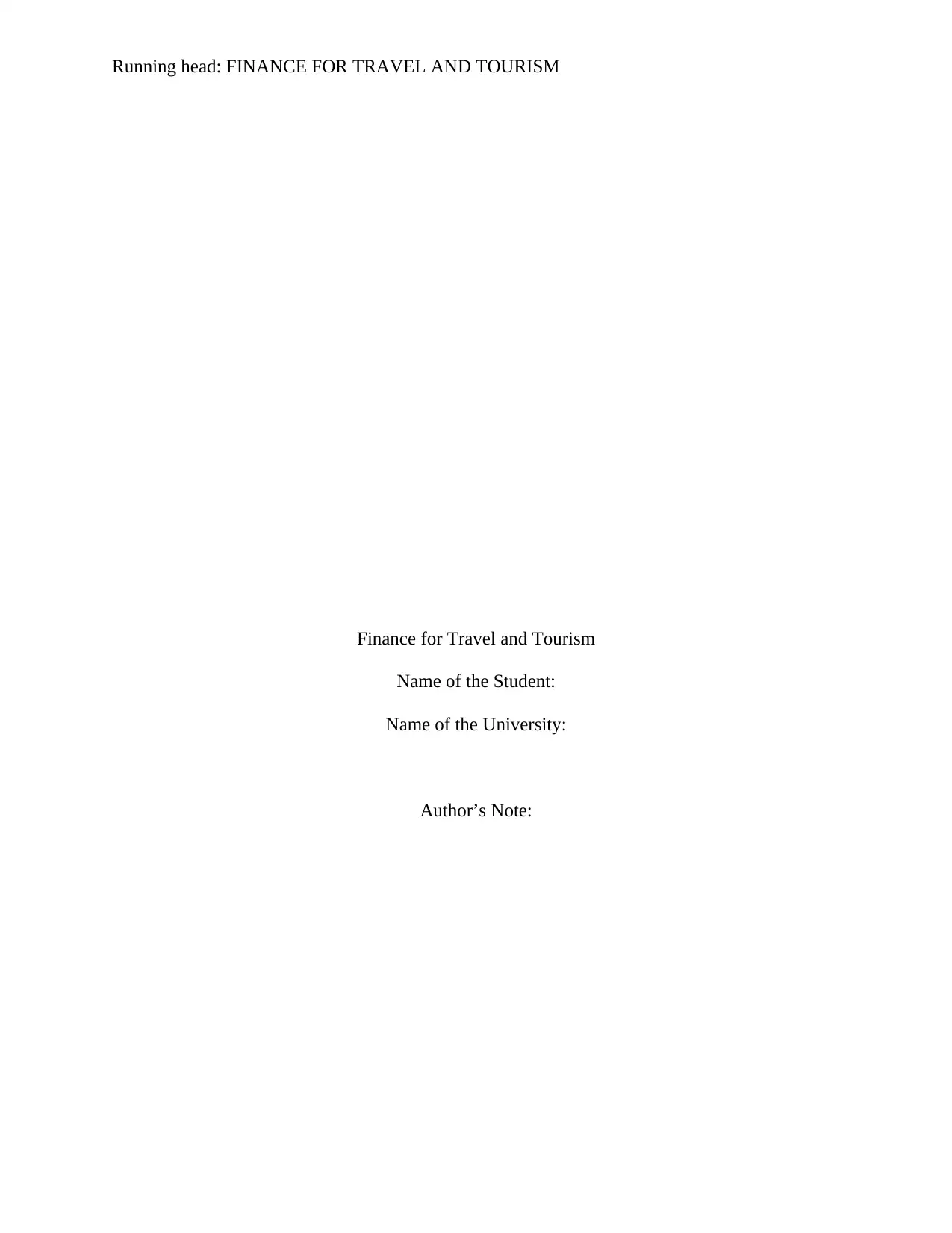
Running head: FINANCE FOR TRAVEL AND TOURISM
Finance for Travel and Tourism
Name of the Student:
Name of the University:
Author’s Note:
Finance for Travel and Tourism
Name of the Student:
Name of the University:
Author’s Note:
Paraphrase This Document
Need a fresh take? Get an instant paraphrase of this document with our AI Paraphraser
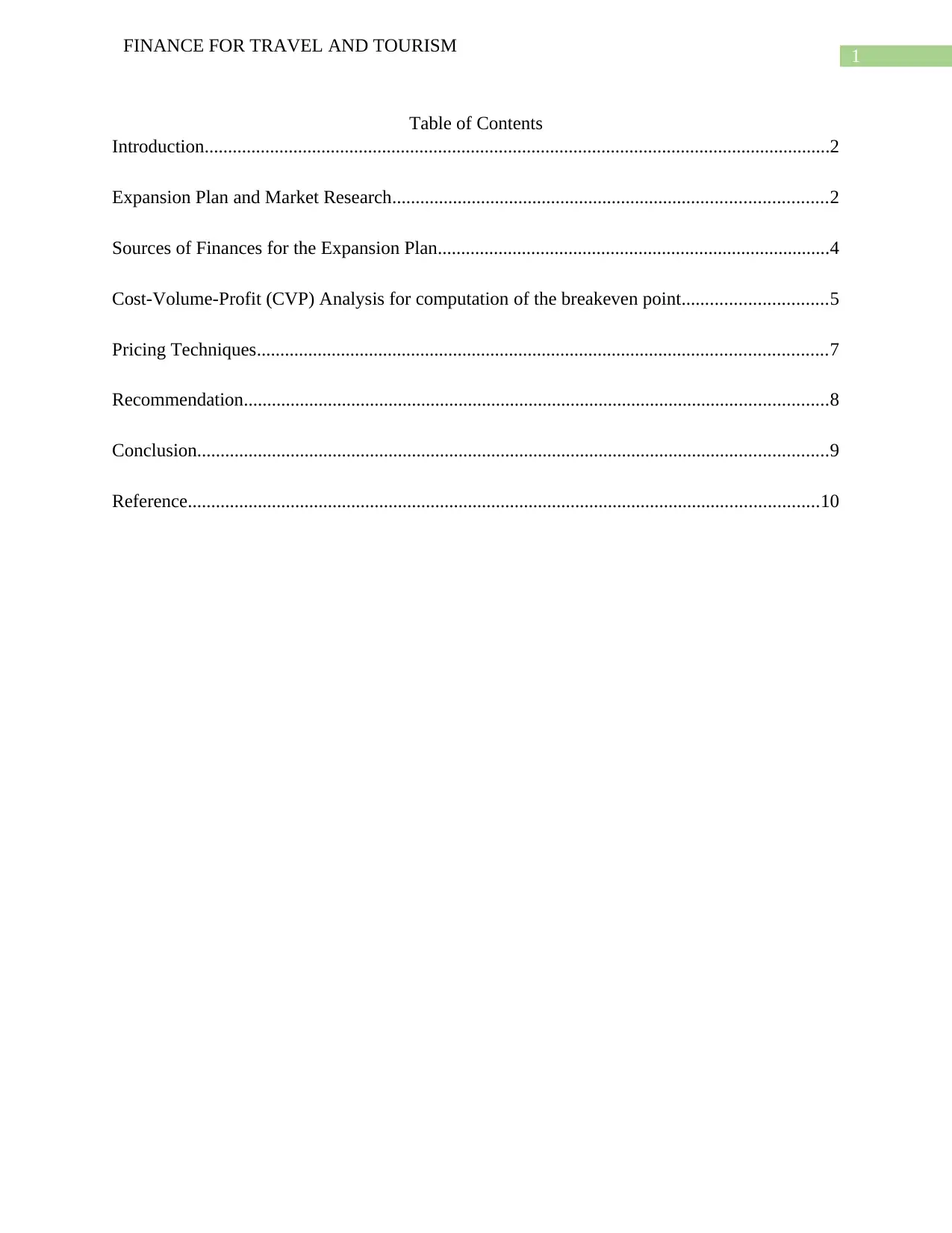
1
FINANCE FOR TRAVEL AND TOURISM
Table of Contents
Introduction......................................................................................................................................2
Expansion Plan and Market Research.............................................................................................2
Sources of Finances for the Expansion Plan....................................................................................4
Cost-Volume-Profit (CVP) Analysis for computation of the breakeven point...............................5
Pricing Techniques..........................................................................................................................7
Recommendation.............................................................................................................................8
Conclusion.......................................................................................................................................9
Reference.......................................................................................................................................10
FINANCE FOR TRAVEL AND TOURISM
Table of Contents
Introduction......................................................................................................................................2
Expansion Plan and Market Research.............................................................................................2
Sources of Finances for the Expansion Plan....................................................................................4
Cost-Volume-Profit (CVP) Analysis for computation of the breakeven point...............................5
Pricing Techniques..........................................................................................................................7
Recommendation.............................................................................................................................8
Conclusion.......................................................................................................................................9
Reference.......................................................................................................................................10
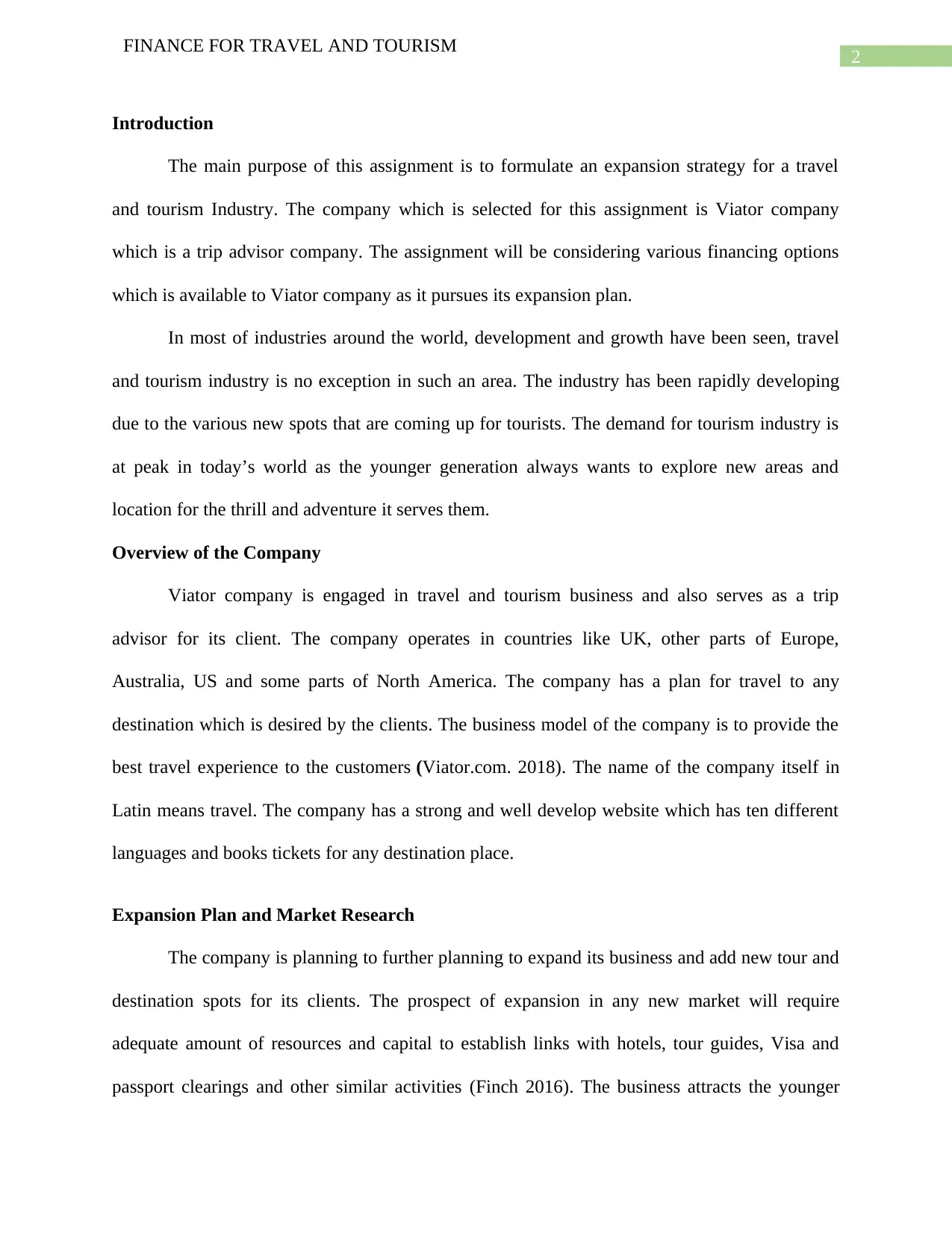
2
FINANCE FOR TRAVEL AND TOURISM
Introduction
The main purpose of this assignment is to formulate an expansion strategy for a travel
and tourism Industry. The company which is selected for this assignment is Viator company
which is a trip advisor company. The assignment will be considering various financing options
which is available to Viator company as it pursues its expansion plan.
In most of industries around the world, development and growth have been seen, travel
and tourism industry is no exception in such an area. The industry has been rapidly developing
due to the various new spots that are coming up for tourists. The demand for tourism industry is
at peak in today’s world as the younger generation always wants to explore new areas and
location for the thrill and adventure it serves them.
Overview of the Company
Viator company is engaged in travel and tourism business and also serves as a trip
advisor for its client. The company operates in countries like UK, other parts of Europe,
Australia, US and some parts of North America. The company has a plan for travel to any
destination which is desired by the clients. The business model of the company is to provide the
best travel experience to the customers (Viator.com. 2018). The name of the company itself in
Latin means travel. The company has a strong and well develop website which has ten different
languages and books tickets for any destination place.
Expansion Plan and Market Research
The company is planning to further planning to expand its business and add new tour and
destination spots for its clients. The prospect of expansion in any new market will require
adequate amount of resources and capital to establish links with hotels, tour guides, Visa and
passport clearings and other similar activities (Finch 2016). The business attracts the younger
FINANCE FOR TRAVEL AND TOURISM
Introduction
The main purpose of this assignment is to formulate an expansion strategy for a travel
and tourism Industry. The company which is selected for this assignment is Viator company
which is a trip advisor company. The assignment will be considering various financing options
which is available to Viator company as it pursues its expansion plan.
In most of industries around the world, development and growth have been seen, travel
and tourism industry is no exception in such an area. The industry has been rapidly developing
due to the various new spots that are coming up for tourists. The demand for tourism industry is
at peak in today’s world as the younger generation always wants to explore new areas and
location for the thrill and adventure it serves them.
Overview of the Company
Viator company is engaged in travel and tourism business and also serves as a trip
advisor for its client. The company operates in countries like UK, other parts of Europe,
Australia, US and some parts of North America. The company has a plan for travel to any
destination which is desired by the clients. The business model of the company is to provide the
best travel experience to the customers (Viator.com. 2018). The name of the company itself in
Latin means travel. The company has a strong and well develop website which has ten different
languages and books tickets for any destination place.
Expansion Plan and Market Research
The company is planning to further planning to expand its business and add new tour and
destination spots for its clients. The prospect of expansion in any new market will require
adequate amount of resources and capital to establish links with hotels, tour guides, Visa and
passport clearings and other similar activities (Finch 2016). The business attracts the younger
⊘ This is a preview!⊘
Do you want full access?
Subscribe today to unlock all pages.

Trusted by 1+ million students worldwide
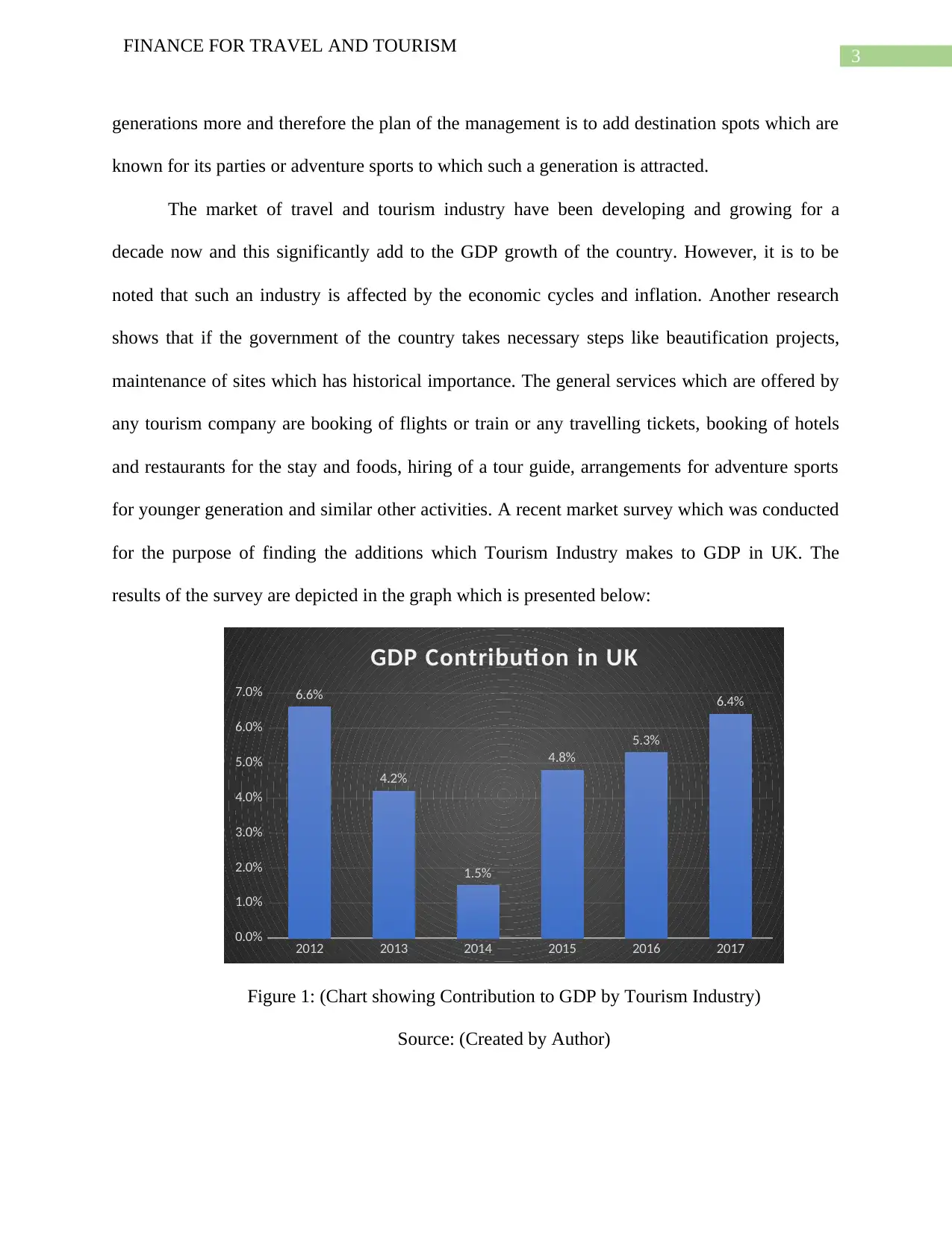
3
FINANCE FOR TRAVEL AND TOURISM
generations more and therefore the plan of the management is to add destination spots which are
known for its parties or adventure sports to which such a generation is attracted.
The market of travel and tourism industry have been developing and growing for a
decade now and this significantly add to the GDP growth of the country. However, it is to be
noted that such an industry is affected by the economic cycles and inflation. Another research
shows that if the government of the country takes necessary steps like beautification projects,
maintenance of sites which has historical importance. The general services which are offered by
any tourism company are booking of flights or train or any travelling tickets, booking of hotels
and restaurants for the stay and foods, hiring of a tour guide, arrangements for adventure sports
for younger generation and similar other activities. A recent market survey which was conducted
for the purpose of finding the additions which Tourism Industry makes to GDP in UK. The
results of the survey are depicted in the graph which is presented below:
2012 2013 2014 2015 2016 2017
0.0%
1.0%
2.0%
3.0%
4.0%
5.0%
6.0%
7.0% 6.6%
4.2%
1.5%
4.8%
5.3%
6.4%
GDP Contributi on in UK
Figure 1: (Chart showing Contribution to GDP by Tourism Industry)
Source: (Created by Author)
FINANCE FOR TRAVEL AND TOURISM
generations more and therefore the plan of the management is to add destination spots which are
known for its parties or adventure sports to which such a generation is attracted.
The market of travel and tourism industry have been developing and growing for a
decade now and this significantly add to the GDP growth of the country. However, it is to be
noted that such an industry is affected by the economic cycles and inflation. Another research
shows that if the government of the country takes necessary steps like beautification projects,
maintenance of sites which has historical importance. The general services which are offered by
any tourism company are booking of flights or train or any travelling tickets, booking of hotels
and restaurants for the stay and foods, hiring of a tour guide, arrangements for adventure sports
for younger generation and similar other activities. A recent market survey which was conducted
for the purpose of finding the additions which Tourism Industry makes to GDP in UK. The
results of the survey are depicted in the graph which is presented below:
2012 2013 2014 2015 2016 2017
0.0%
1.0%
2.0%
3.0%
4.0%
5.0%
6.0%
7.0% 6.6%
4.2%
1.5%
4.8%
5.3%
6.4%
GDP Contributi on in UK
Figure 1: (Chart showing Contribution to GDP by Tourism Industry)
Source: (Created by Author)
Paraphrase This Document
Need a fresh take? Get an instant paraphrase of this document with our AI Paraphraser
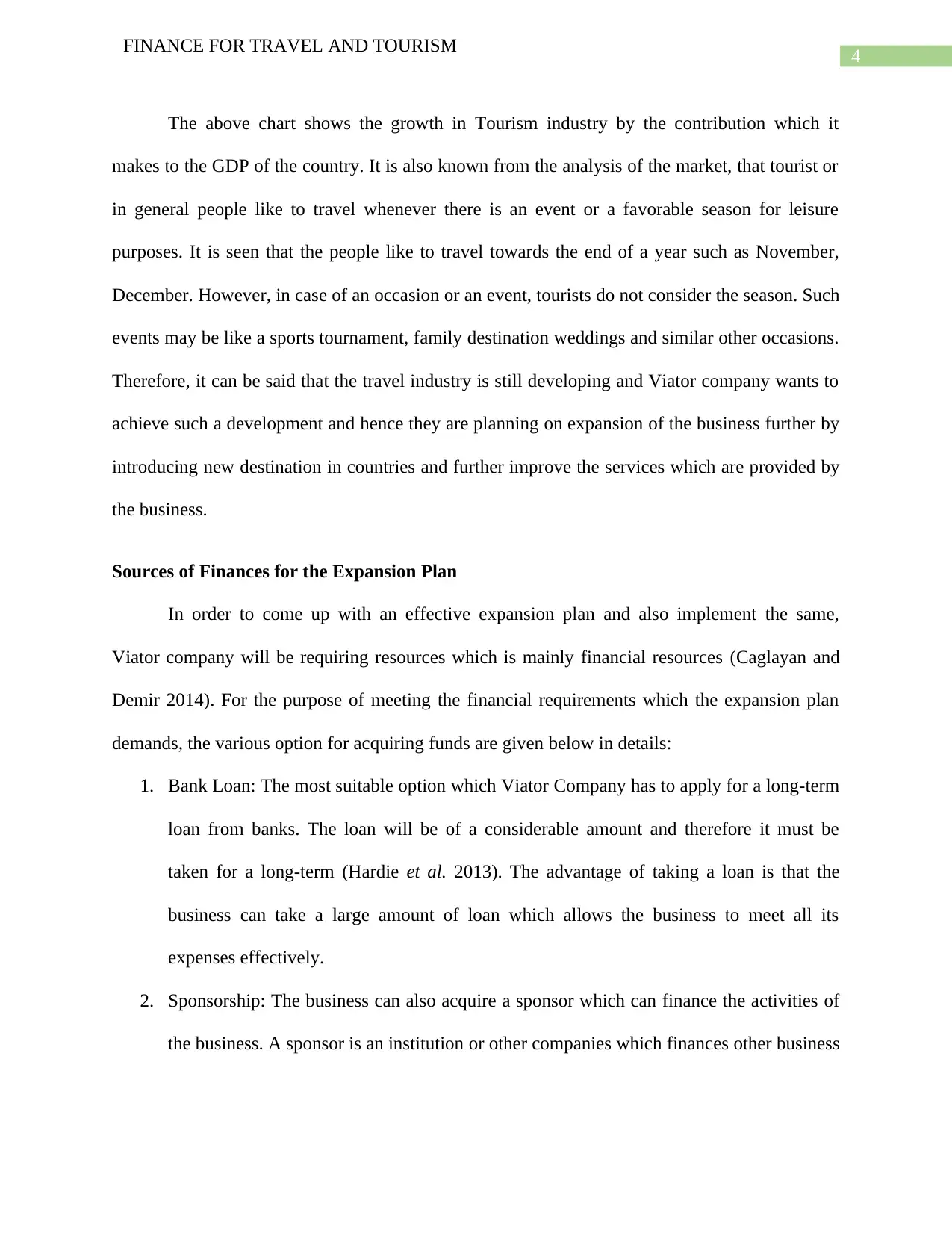
4
FINANCE FOR TRAVEL AND TOURISM
The above chart shows the growth in Tourism industry by the contribution which it
makes to the GDP of the country. It is also known from the analysis of the market, that tourist or
in general people like to travel whenever there is an event or a favorable season for leisure
purposes. It is seen that the people like to travel towards the end of a year such as November,
December. However, in case of an occasion or an event, tourists do not consider the season. Such
events may be like a sports tournament, family destination weddings and similar other occasions.
Therefore, it can be said that the travel industry is still developing and Viator company wants to
achieve such a development and hence they are planning on expansion of the business further by
introducing new destination in countries and further improve the services which are provided by
the business.
Sources of Finances for the Expansion Plan
In order to come up with an effective expansion plan and also implement the same,
Viator company will be requiring resources which is mainly financial resources (Caglayan and
Demir 2014). For the purpose of meeting the financial requirements which the expansion plan
demands, the various option for acquiring funds are given below in details:
1. Bank Loan: The most suitable option which Viator Company has to apply for a long-term
loan from banks. The loan will be of a considerable amount and therefore it must be
taken for a long-term (Hardie et al. 2013). The advantage of taking a loan is that the
business can take a large amount of loan which allows the business to meet all its
expenses effectively.
2. Sponsorship: The business can also acquire a sponsor which can finance the activities of
the business. A sponsor is an institution or other companies which finances other business
FINANCE FOR TRAVEL AND TOURISM
The above chart shows the growth in Tourism industry by the contribution which it
makes to the GDP of the country. It is also known from the analysis of the market, that tourist or
in general people like to travel whenever there is an event or a favorable season for leisure
purposes. It is seen that the people like to travel towards the end of a year such as November,
December. However, in case of an occasion or an event, tourists do not consider the season. Such
events may be like a sports tournament, family destination weddings and similar other occasions.
Therefore, it can be said that the travel industry is still developing and Viator company wants to
achieve such a development and hence they are planning on expansion of the business further by
introducing new destination in countries and further improve the services which are provided by
the business.
Sources of Finances for the Expansion Plan
In order to come up with an effective expansion plan and also implement the same,
Viator company will be requiring resources which is mainly financial resources (Caglayan and
Demir 2014). For the purpose of meeting the financial requirements which the expansion plan
demands, the various option for acquiring funds are given below in details:
1. Bank Loan: The most suitable option which Viator Company has to apply for a long-term
loan from banks. The loan will be of a considerable amount and therefore it must be
taken for a long-term (Hardie et al. 2013). The advantage of taking a loan is that the
business can take a large amount of loan which allows the business to meet all its
expenses effectively.
2. Sponsorship: The business can also acquire a sponsor which can finance the activities of
the business. A sponsor is an institution or other companies which finances other business
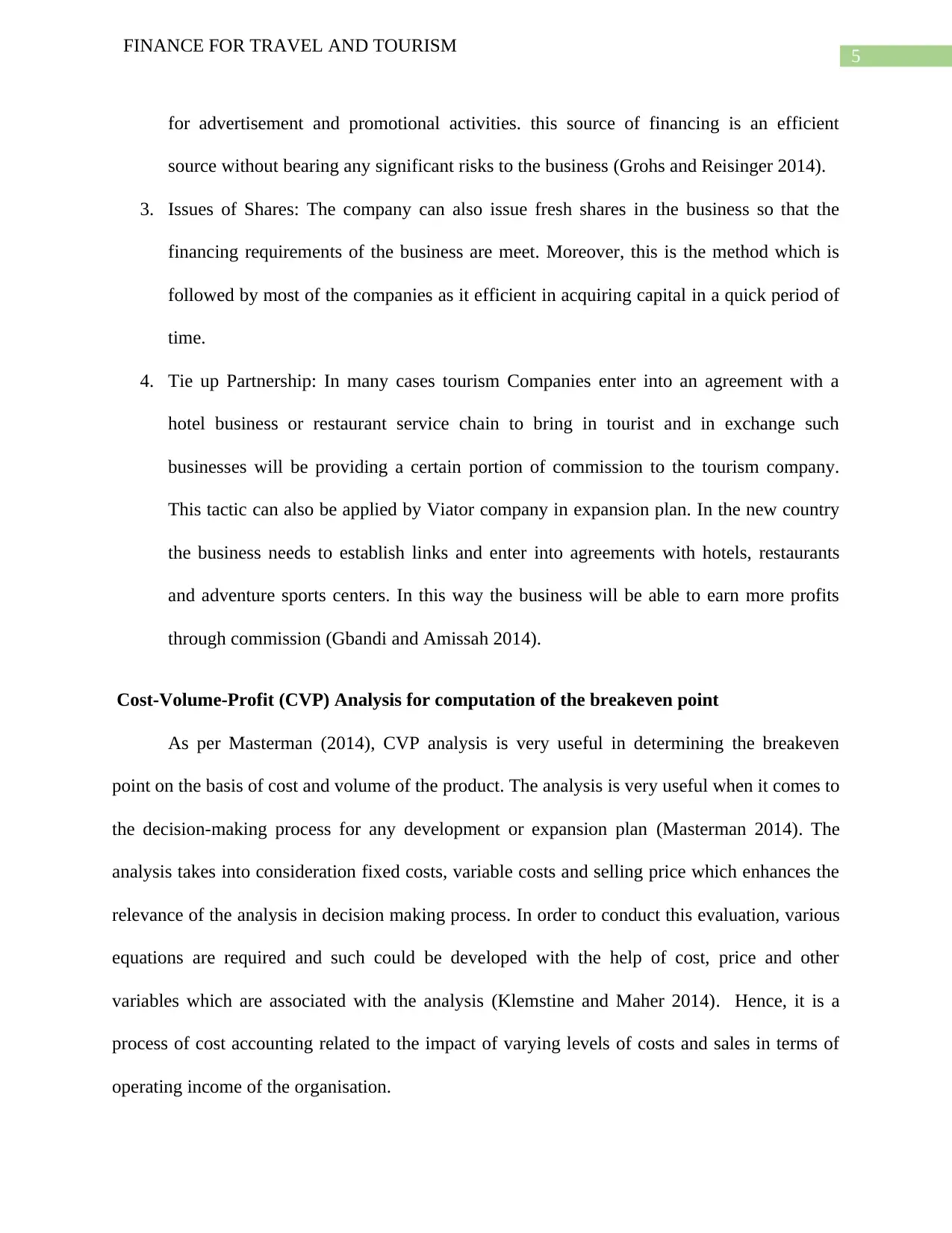
5
FINANCE FOR TRAVEL AND TOURISM
for advertisement and promotional activities. this source of financing is an efficient
source without bearing any significant risks to the business (Grohs and Reisinger 2014).
3. Issues of Shares: The company can also issue fresh shares in the business so that the
financing requirements of the business are meet. Moreover, this is the method which is
followed by most of the companies as it efficient in acquiring capital in a quick period of
time.
4. Tie up Partnership: In many cases tourism Companies enter into an agreement with a
hotel business or restaurant service chain to bring in tourist and in exchange such
businesses will be providing a certain portion of commission to the tourism company.
This tactic can also be applied by Viator company in expansion plan. In the new country
the business needs to establish links and enter into agreements with hotels, restaurants
and adventure sports centers. In this way the business will be able to earn more profits
through commission (Gbandi and Amissah 2014).
Cost-Volume-Profit (CVP) Analysis for computation of the breakeven point
As per Masterman (2014), CVP analysis is very useful in determining the breakeven
point on the basis of cost and volume of the product. The analysis is very useful when it comes to
the decision-making process for any development or expansion plan (Masterman 2014). The
analysis takes into consideration fixed costs, variable costs and selling price which enhances the
relevance of the analysis in decision making process. In order to conduct this evaluation, various
equations are required and such could be developed with the help of cost, price and other
variables which are associated with the analysis (Klemstine and Maher 2014). Hence, it is a
process of cost accounting related to the impact of varying levels of costs and sales in terms of
operating income of the organisation.
FINANCE FOR TRAVEL AND TOURISM
for advertisement and promotional activities. this source of financing is an efficient
source without bearing any significant risks to the business (Grohs and Reisinger 2014).
3. Issues of Shares: The company can also issue fresh shares in the business so that the
financing requirements of the business are meet. Moreover, this is the method which is
followed by most of the companies as it efficient in acquiring capital in a quick period of
time.
4. Tie up Partnership: In many cases tourism Companies enter into an agreement with a
hotel business or restaurant service chain to bring in tourist and in exchange such
businesses will be providing a certain portion of commission to the tourism company.
This tactic can also be applied by Viator company in expansion plan. In the new country
the business needs to establish links and enter into agreements with hotels, restaurants
and adventure sports centers. In this way the business will be able to earn more profits
through commission (Gbandi and Amissah 2014).
Cost-Volume-Profit (CVP) Analysis for computation of the breakeven point
As per Masterman (2014), CVP analysis is very useful in determining the breakeven
point on the basis of cost and volume of the product. The analysis is very useful when it comes to
the decision-making process for any development or expansion plan (Masterman 2014). The
analysis takes into consideration fixed costs, variable costs and selling price which enhances the
relevance of the analysis in decision making process. In order to conduct this evaluation, various
equations are required and such could be developed with the help of cost, price and other
variables which are associated with the analysis (Klemstine and Maher 2014). Hence, it is a
process of cost accounting related to the impact of varying levels of costs and sales in terms of
operating income of the organisation.
⊘ This is a preview!⊘
Do you want full access?
Subscribe today to unlock all pages.

Trusted by 1+ million students worldwide
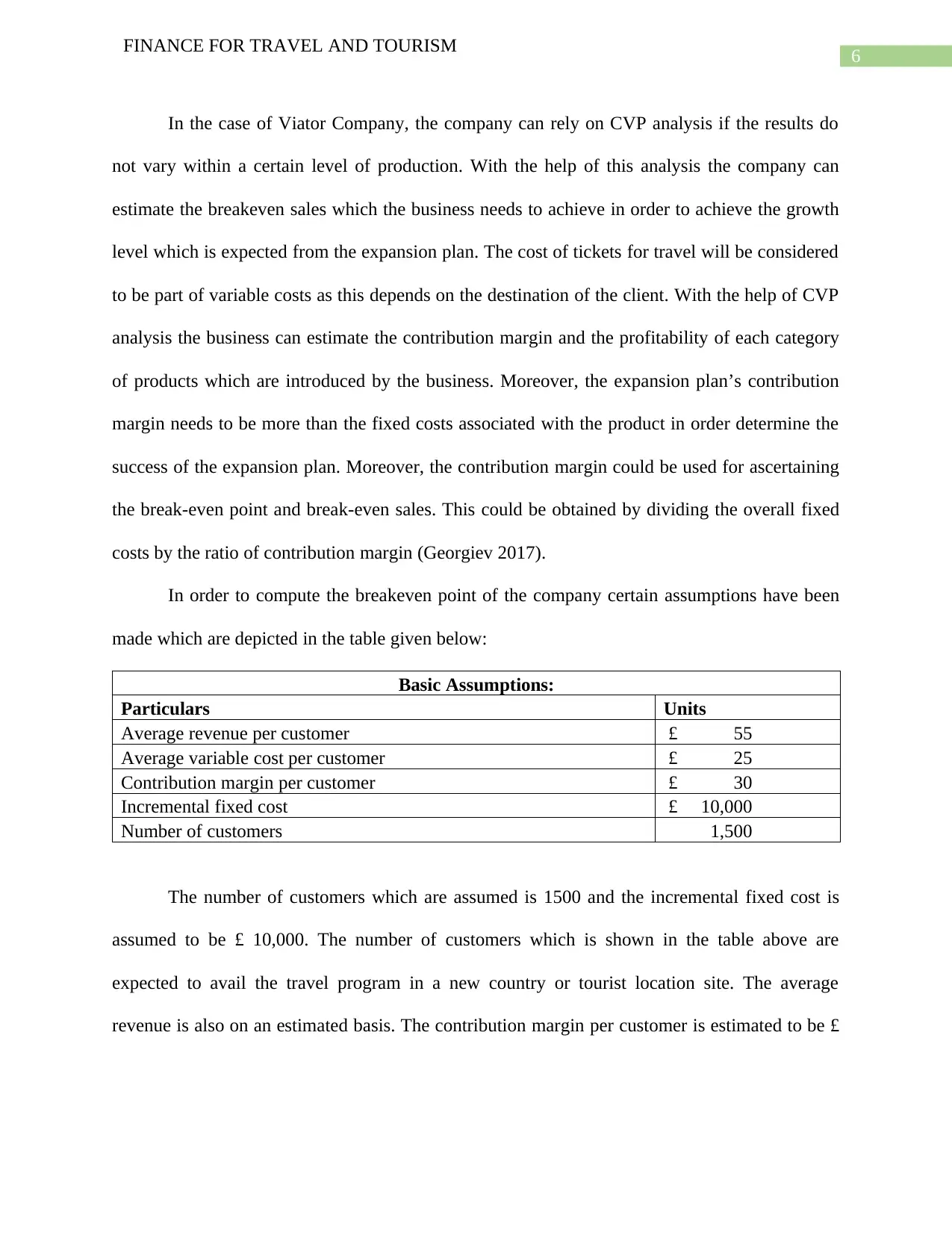
6
FINANCE FOR TRAVEL AND TOURISM
In the case of Viator Company, the company can rely on CVP analysis if the results do
not vary within a certain level of production. With the help of this analysis the company can
estimate the breakeven sales which the business needs to achieve in order to achieve the growth
level which is expected from the expansion plan. The cost of tickets for travel will be considered
to be part of variable costs as this depends on the destination of the client. With the help of CVP
analysis the business can estimate the contribution margin and the profitability of each category
of products which are introduced by the business. Moreover, the expansion plan’s contribution
margin needs to be more than the fixed costs associated with the product in order determine the
success of the expansion plan. Moreover, the contribution margin could be used for ascertaining
the break-even point and break-even sales. This could be obtained by dividing the overall fixed
costs by the ratio of contribution margin (Georgiev 2017).
In order to compute the breakeven point of the company certain assumptions have been
made which are depicted in the table given below:
Basic Assumptions:
Particulars Units
Average revenue per customer £ 55
Average variable cost per customer £ 25
Contribution margin per customer £ 30
Incremental fixed cost £ 10,000
Number of customers 1,500
The number of customers which are assumed is 1500 and the incremental fixed cost is
assumed to be £ 10,000. The number of customers which is shown in the table above are
expected to avail the travel program in a new country or tourist location site. The average
revenue is also on an estimated basis. The contribution margin per customer is estimated to be £
FINANCE FOR TRAVEL AND TOURISM
In the case of Viator Company, the company can rely on CVP analysis if the results do
not vary within a certain level of production. With the help of this analysis the company can
estimate the breakeven sales which the business needs to achieve in order to achieve the growth
level which is expected from the expansion plan. The cost of tickets for travel will be considered
to be part of variable costs as this depends on the destination of the client. With the help of CVP
analysis the business can estimate the contribution margin and the profitability of each category
of products which are introduced by the business. Moreover, the expansion plan’s contribution
margin needs to be more than the fixed costs associated with the product in order determine the
success of the expansion plan. Moreover, the contribution margin could be used for ascertaining
the break-even point and break-even sales. This could be obtained by dividing the overall fixed
costs by the ratio of contribution margin (Georgiev 2017).
In order to compute the breakeven point of the company certain assumptions have been
made which are depicted in the table given below:
Basic Assumptions:
Particulars Units
Average revenue per customer £ 55
Average variable cost per customer £ 25
Contribution margin per customer £ 30
Incremental fixed cost £ 10,000
Number of customers 1,500
The number of customers which are assumed is 1500 and the incremental fixed cost is
assumed to be £ 10,000. The number of customers which is shown in the table above are
expected to avail the travel program in a new country or tourist location site. The average
revenue is also on an estimated basis. The contribution margin per customer is estimated to be £
Paraphrase This Document
Need a fresh take? Get an instant paraphrase of this document with our AI Paraphraser
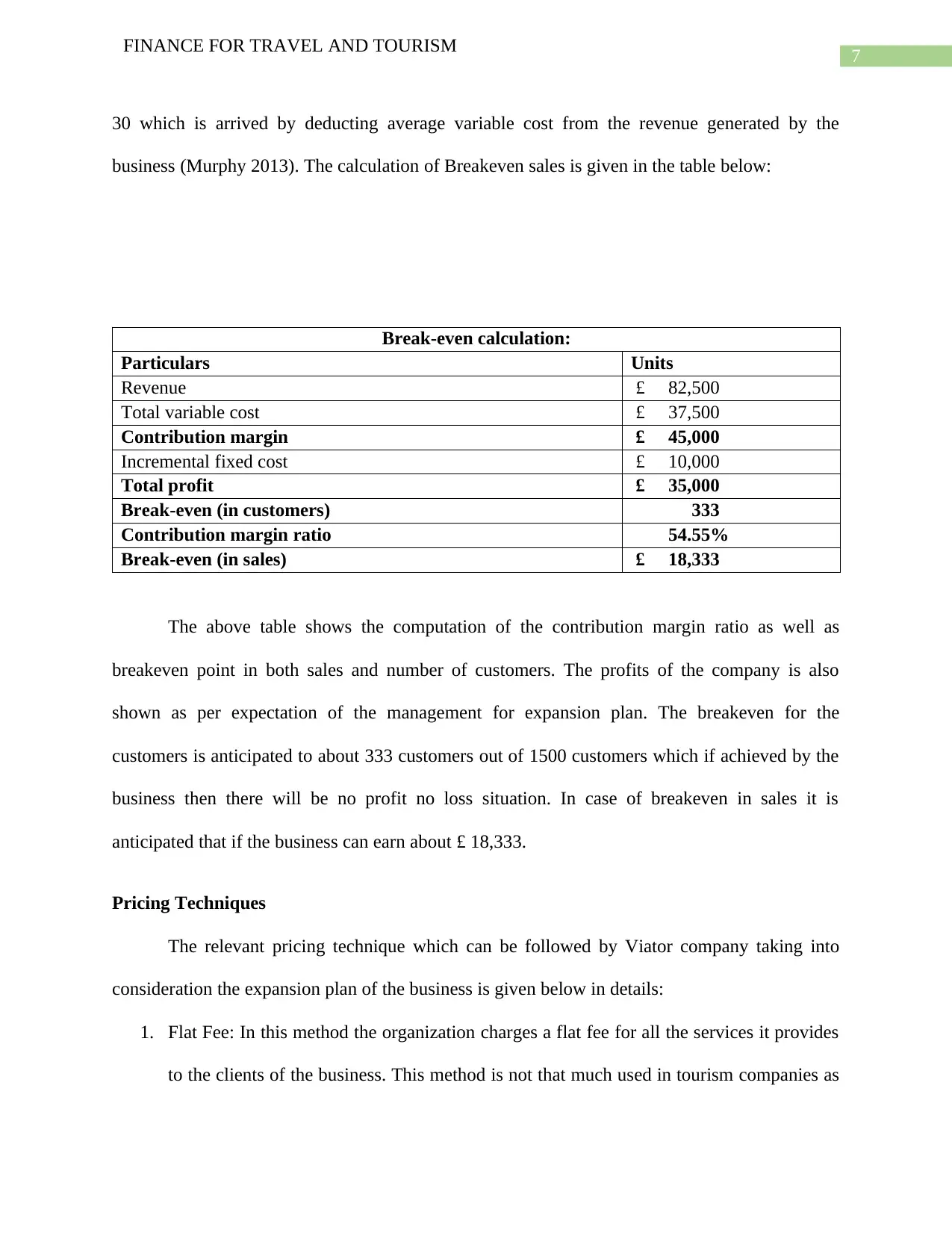
7
FINANCE FOR TRAVEL AND TOURISM
30 which is arrived by deducting average variable cost from the revenue generated by the
business (Murphy 2013). The calculation of Breakeven sales is given in the table below:
Break-even calculation:
Particulars Units
Revenue £ 82,500
Total variable cost £ 37,500
Contribution margin £ 45,000
Incremental fixed cost £ 10,000
Total profit £ 35,000
Break-even (in customers) 333
Contribution margin ratio 54.55%
Break-even (in sales) £ 18,333
The above table shows the computation of the contribution margin ratio as well as
breakeven point in both sales and number of customers. The profits of the company is also
shown as per expectation of the management for expansion plan. The breakeven for the
customers is anticipated to about 333 customers out of 1500 customers which if achieved by the
business then there will be no profit no loss situation. In case of breakeven in sales it is
anticipated that if the business can earn about £ 18,333.
Pricing Techniques
The relevant pricing technique which can be followed by Viator company taking into
consideration the expansion plan of the business is given below in details:
1. Flat Fee: In this method the organization charges a flat fee for all the services it provides
to the clients of the business. This method is not that much used in tourism companies as
FINANCE FOR TRAVEL AND TOURISM
30 which is arrived by deducting average variable cost from the revenue generated by the
business (Murphy 2013). The calculation of Breakeven sales is given in the table below:
Break-even calculation:
Particulars Units
Revenue £ 82,500
Total variable cost £ 37,500
Contribution margin £ 45,000
Incremental fixed cost £ 10,000
Total profit £ 35,000
Break-even (in customers) 333
Contribution margin ratio 54.55%
Break-even (in sales) £ 18,333
The above table shows the computation of the contribution margin ratio as well as
breakeven point in both sales and number of customers. The profits of the company is also
shown as per expectation of the management for expansion plan. The breakeven for the
customers is anticipated to about 333 customers out of 1500 customers which if achieved by the
business then there will be no profit no loss situation. In case of breakeven in sales it is
anticipated that if the business can earn about £ 18,333.
Pricing Techniques
The relevant pricing technique which can be followed by Viator company taking into
consideration the expansion plan of the business is given below in details:
1. Flat Fee: In this method the organization charges a flat fee for all the services it provides
to the clients of the business. This method is not that much used in tourism companies as
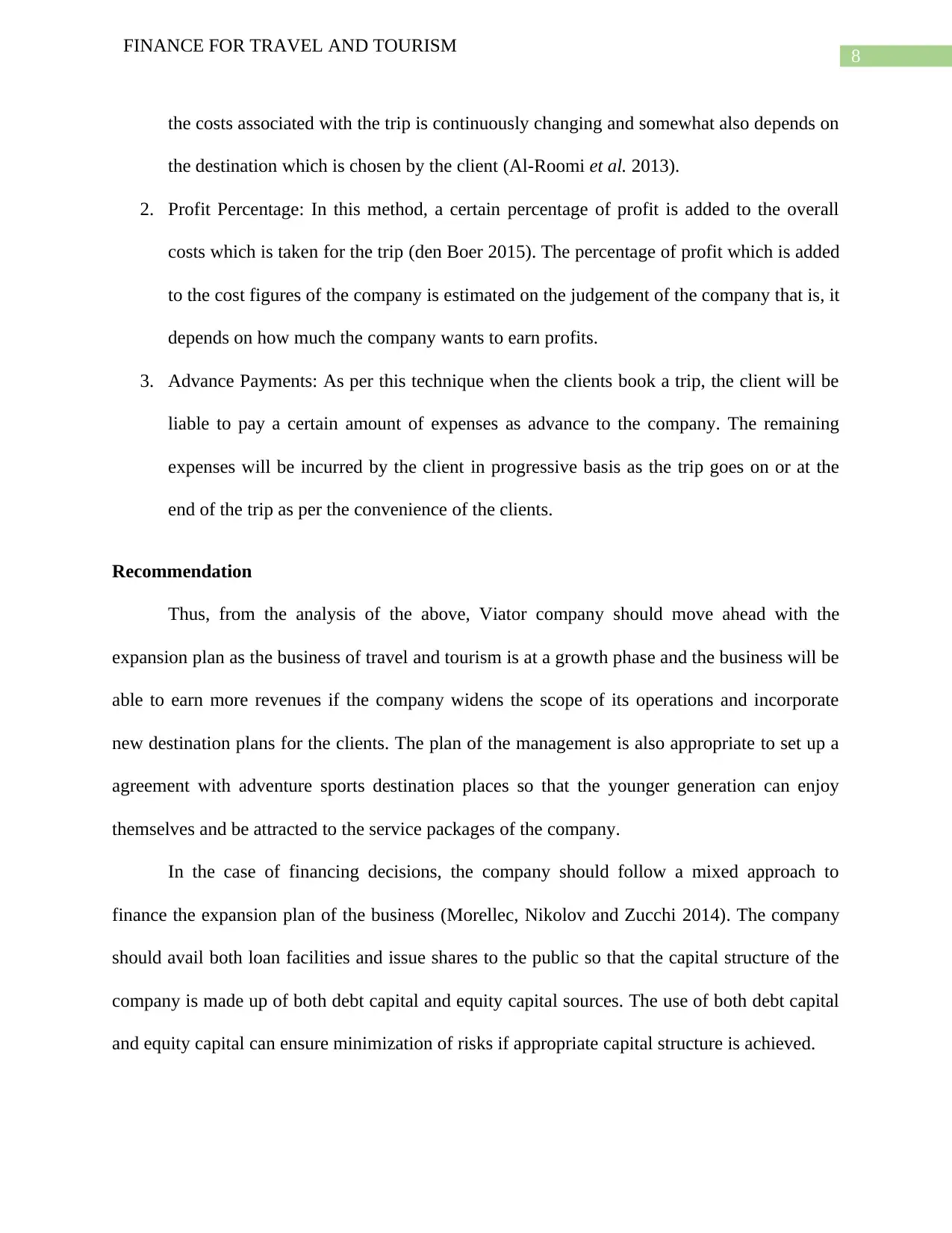
8
FINANCE FOR TRAVEL AND TOURISM
the costs associated with the trip is continuously changing and somewhat also depends on
the destination which is chosen by the client (Al-Roomi et al. 2013).
2. Profit Percentage: In this method, a certain percentage of profit is added to the overall
costs which is taken for the trip (den Boer 2015). The percentage of profit which is added
to the cost figures of the company is estimated on the judgement of the company that is, it
depends on how much the company wants to earn profits.
3. Advance Payments: As per this technique when the clients book a trip, the client will be
liable to pay a certain amount of expenses as advance to the company. The remaining
expenses will be incurred by the client in progressive basis as the trip goes on or at the
end of the trip as per the convenience of the clients.
Recommendation
Thus, from the analysis of the above, Viator company should move ahead with the
expansion plan as the business of travel and tourism is at a growth phase and the business will be
able to earn more revenues if the company widens the scope of its operations and incorporate
new destination plans for the clients. The plan of the management is also appropriate to set up a
agreement with adventure sports destination places so that the younger generation can enjoy
themselves and be attracted to the service packages of the company.
In the case of financing decisions, the company should follow a mixed approach to
finance the expansion plan of the business (Morellec, Nikolov and Zucchi 2014). The company
should avail both loan facilities and issue shares to the public so that the capital structure of the
company is made up of both debt capital and equity capital sources. The use of both debt capital
and equity capital can ensure minimization of risks if appropriate capital structure is achieved.
FINANCE FOR TRAVEL AND TOURISM
the costs associated with the trip is continuously changing and somewhat also depends on
the destination which is chosen by the client (Al-Roomi et al. 2013).
2. Profit Percentage: In this method, a certain percentage of profit is added to the overall
costs which is taken for the trip (den Boer 2015). The percentage of profit which is added
to the cost figures of the company is estimated on the judgement of the company that is, it
depends on how much the company wants to earn profits.
3. Advance Payments: As per this technique when the clients book a trip, the client will be
liable to pay a certain amount of expenses as advance to the company. The remaining
expenses will be incurred by the client in progressive basis as the trip goes on or at the
end of the trip as per the convenience of the clients.
Recommendation
Thus, from the analysis of the above, Viator company should move ahead with the
expansion plan as the business of travel and tourism is at a growth phase and the business will be
able to earn more revenues if the company widens the scope of its operations and incorporate
new destination plans for the clients. The plan of the management is also appropriate to set up a
agreement with adventure sports destination places so that the younger generation can enjoy
themselves and be attracted to the service packages of the company.
In the case of financing decisions, the company should follow a mixed approach to
finance the expansion plan of the business (Morellec, Nikolov and Zucchi 2014). The company
should avail both loan facilities and issue shares to the public so that the capital structure of the
company is made up of both debt capital and equity capital sources. The use of both debt capital
and equity capital can ensure minimization of risks if appropriate capital structure is achieved.
⊘ This is a preview!⊘
Do you want full access?
Subscribe today to unlock all pages.

Trusted by 1+ million students worldwide
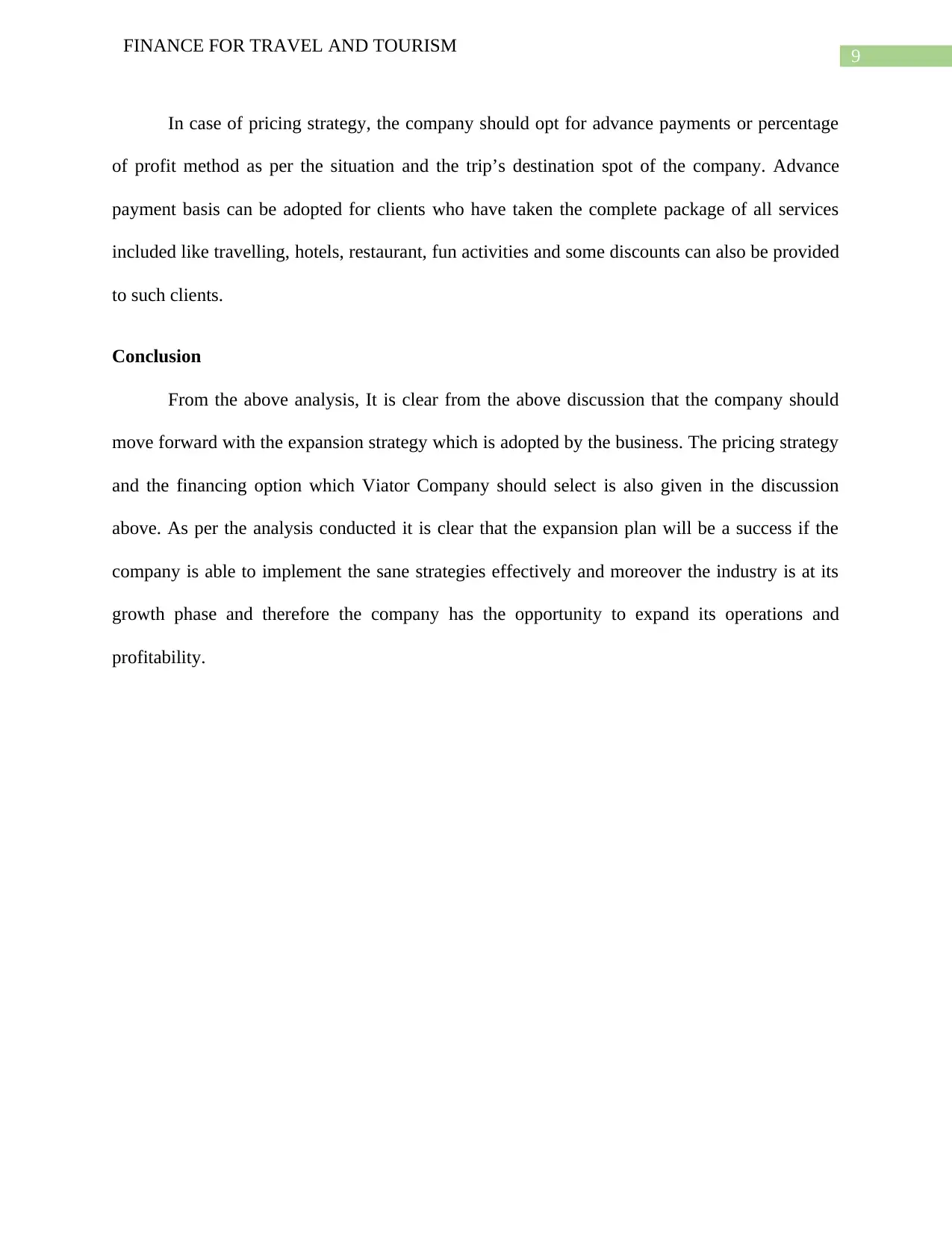
9
FINANCE FOR TRAVEL AND TOURISM
In case of pricing strategy, the company should opt for advance payments or percentage
of profit method as per the situation and the trip’s destination spot of the company. Advance
payment basis can be adopted for clients who have taken the complete package of all services
included like travelling, hotels, restaurant, fun activities and some discounts can also be provided
to such clients.
Conclusion
From the above analysis, It is clear from the above discussion that the company should
move forward with the expansion strategy which is adopted by the business. The pricing strategy
and the financing option which Viator Company should select is also given in the discussion
above. As per the analysis conducted it is clear that the expansion plan will be a success if the
company is able to implement the sane strategies effectively and moreover the industry is at its
growth phase and therefore the company has the opportunity to expand its operations and
profitability.
FINANCE FOR TRAVEL AND TOURISM
In case of pricing strategy, the company should opt for advance payments or percentage
of profit method as per the situation and the trip’s destination spot of the company. Advance
payment basis can be adopted for clients who have taken the complete package of all services
included like travelling, hotels, restaurant, fun activities and some discounts can also be provided
to such clients.
Conclusion
From the above analysis, It is clear from the above discussion that the company should
move forward with the expansion strategy which is adopted by the business. The pricing strategy
and the financing option which Viator Company should select is also given in the discussion
above. As per the analysis conducted it is clear that the expansion plan will be a success if the
company is able to implement the sane strategies effectively and moreover the industry is at its
growth phase and therefore the company has the opportunity to expand its operations and
profitability.
Paraphrase This Document
Need a fresh take? Get an instant paraphrase of this document with our AI Paraphraser
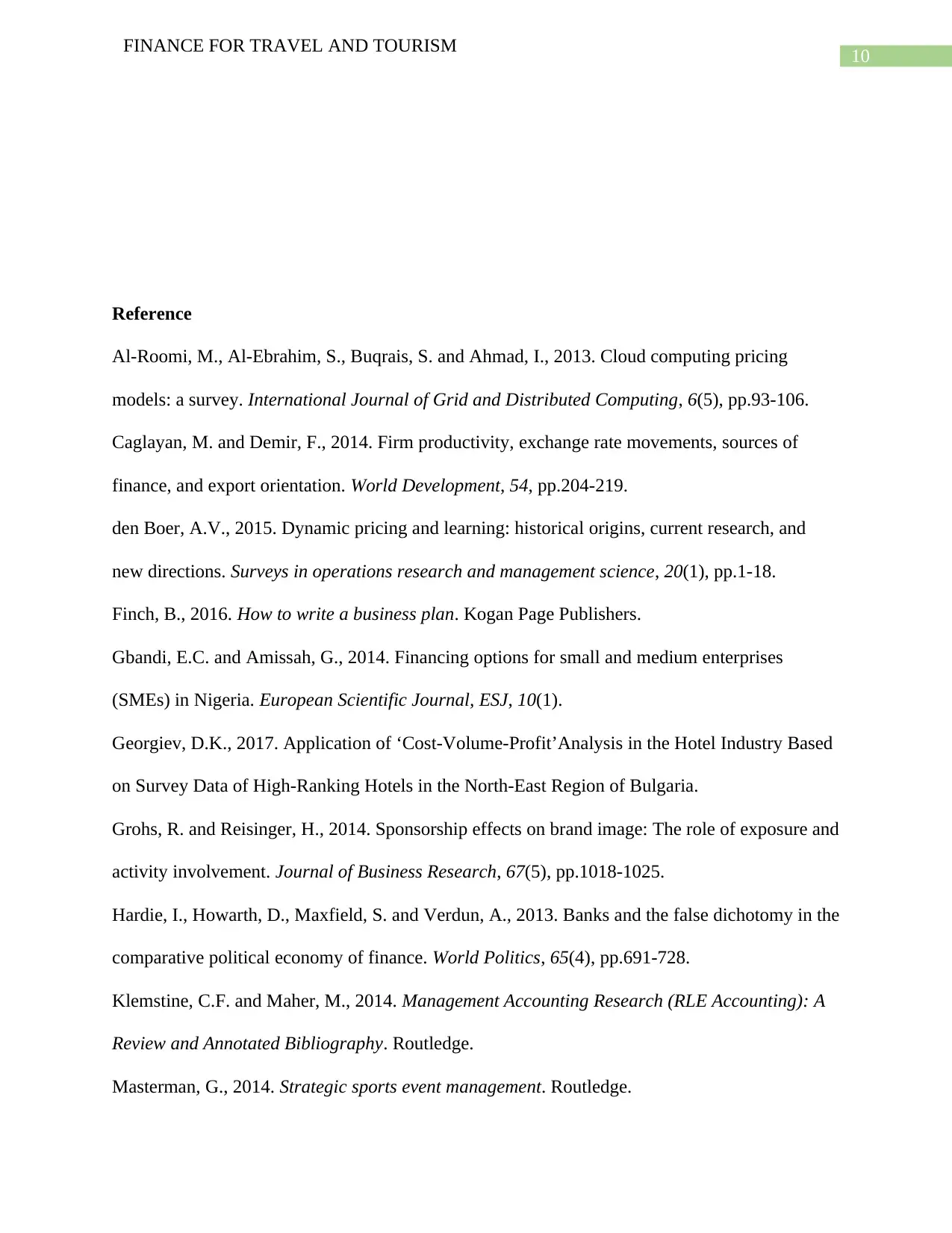
10
FINANCE FOR TRAVEL AND TOURISM
Reference
Al-Roomi, M., Al-Ebrahim, S., Buqrais, S. and Ahmad, I., 2013. Cloud computing pricing
models: a survey. International Journal of Grid and Distributed Computing, 6(5), pp.93-106.
Caglayan, M. and Demir, F., 2014. Firm productivity, exchange rate movements, sources of
finance, and export orientation. World Development, 54, pp.204-219.
den Boer, A.V., 2015. Dynamic pricing and learning: historical origins, current research, and
new directions. Surveys in operations research and management science, 20(1), pp.1-18.
Finch, B., 2016. How to write a business plan. Kogan Page Publishers.
Gbandi, E.C. and Amissah, G., 2014. Financing options for small and medium enterprises
(SMEs) in Nigeria. European Scientific Journal, ESJ, 10(1).
Georgiev, D.K., 2017. Application of ‘Cost-Volume-Profit’Analysis in the Hotel Industry Based
on Survey Data of High-Ranking Hotels in the North-East Region of Bulgaria.
Grohs, R. and Reisinger, H., 2014. Sponsorship effects on brand image: The role of exposure and
activity involvement. Journal of Business Research, 67(5), pp.1018-1025.
Hardie, I., Howarth, D., Maxfield, S. and Verdun, A., 2013. Banks and the false dichotomy in the
comparative political economy of finance. World Politics, 65(4), pp.691-728.
Klemstine, C.F. and Maher, M., 2014. Management Accounting Research (RLE Accounting): A
Review and Annotated Bibliography. Routledge.
Masterman, G., 2014. Strategic sports event management. Routledge.
FINANCE FOR TRAVEL AND TOURISM
Reference
Al-Roomi, M., Al-Ebrahim, S., Buqrais, S. and Ahmad, I., 2013. Cloud computing pricing
models: a survey. International Journal of Grid and Distributed Computing, 6(5), pp.93-106.
Caglayan, M. and Demir, F., 2014. Firm productivity, exchange rate movements, sources of
finance, and export orientation. World Development, 54, pp.204-219.
den Boer, A.V., 2015. Dynamic pricing and learning: historical origins, current research, and
new directions. Surveys in operations research and management science, 20(1), pp.1-18.
Finch, B., 2016. How to write a business plan. Kogan Page Publishers.
Gbandi, E.C. and Amissah, G., 2014. Financing options for small and medium enterprises
(SMEs) in Nigeria. European Scientific Journal, ESJ, 10(1).
Georgiev, D.K., 2017. Application of ‘Cost-Volume-Profit’Analysis in the Hotel Industry Based
on Survey Data of High-Ranking Hotels in the North-East Region of Bulgaria.
Grohs, R. and Reisinger, H., 2014. Sponsorship effects on brand image: The role of exposure and
activity involvement. Journal of Business Research, 67(5), pp.1018-1025.
Hardie, I., Howarth, D., Maxfield, S. and Verdun, A., 2013. Banks and the false dichotomy in the
comparative political economy of finance. World Politics, 65(4), pp.691-728.
Klemstine, C.F. and Maher, M., 2014. Management Accounting Research (RLE Accounting): A
Review and Annotated Bibliography. Routledge.
Masterman, G., 2014. Strategic sports event management. Routledge.
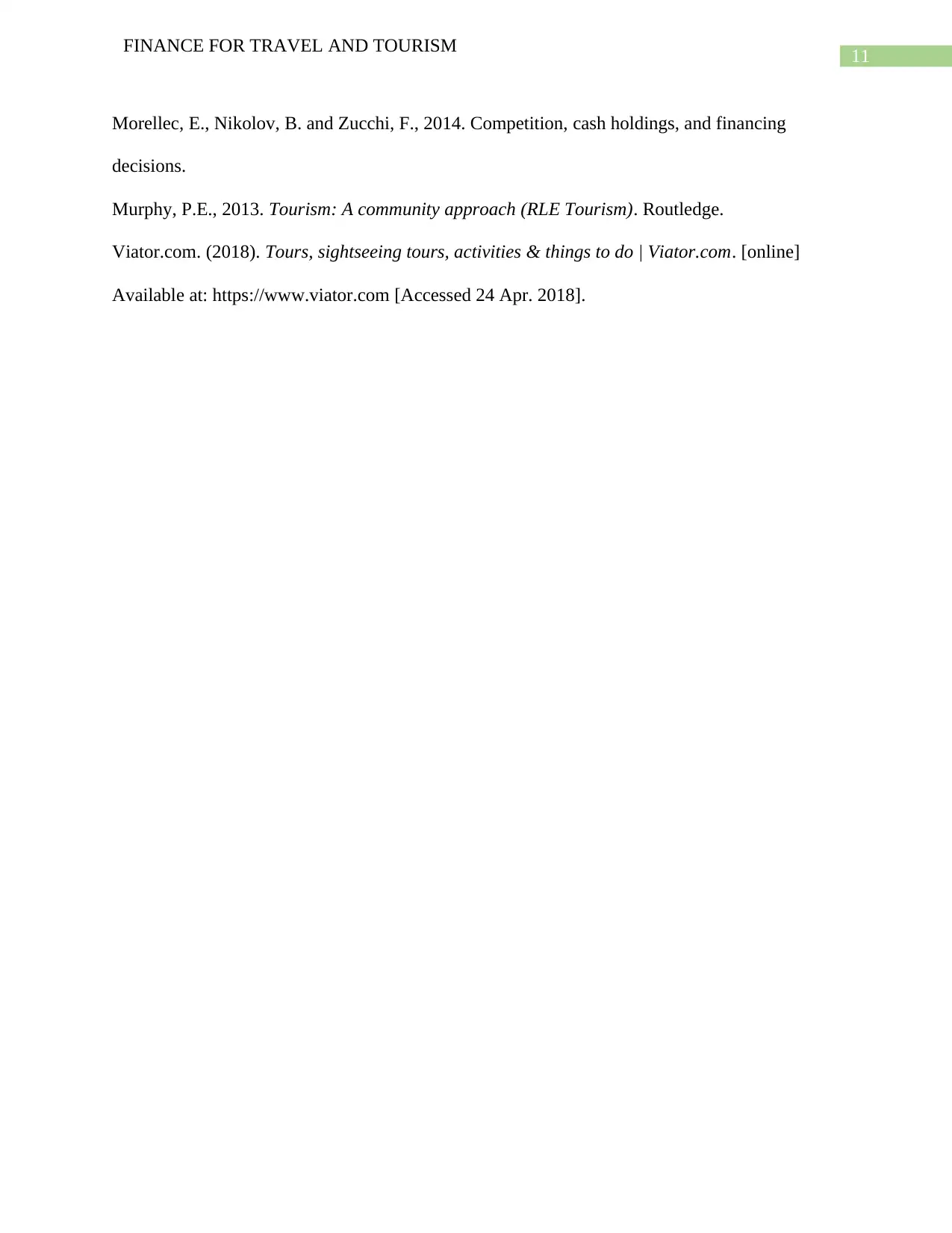
11
FINANCE FOR TRAVEL AND TOURISM
Morellec, E., Nikolov, B. and Zucchi, F., 2014. Competition, cash holdings, and financing
decisions.
Murphy, P.E., 2013. Tourism: A community approach (RLE Tourism). Routledge.
Viator.com. (2018). Tours, sightseeing tours, activities & things to do | Viator.com. [online]
Available at: https://www.viator.com [Accessed 24 Apr. 2018].
FINANCE FOR TRAVEL AND TOURISM
Morellec, E., Nikolov, B. and Zucchi, F., 2014. Competition, cash holdings, and financing
decisions.
Murphy, P.E., 2013. Tourism: A community approach (RLE Tourism). Routledge.
Viator.com. (2018). Tours, sightseeing tours, activities & things to do | Viator.com. [online]
Available at: https://www.viator.com [Accessed 24 Apr. 2018].
⊘ This is a preview!⊘
Do you want full access?
Subscribe today to unlock all pages.

Trusted by 1+ million students worldwide
1 out of 12
Related Documents
Your All-in-One AI-Powered Toolkit for Academic Success.
+13062052269
info@desklib.com
Available 24*7 on WhatsApp / Email
![[object Object]](/_next/static/media/star-bottom.7253800d.svg)
Unlock your academic potential
Copyright © 2020–2025 A2Z Services. All Rights Reserved. Developed and managed by ZUCOL.




